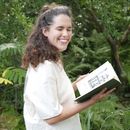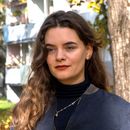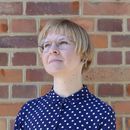With an object-centered approach, the IRTG seeks to implement new tools to analyze European Jewish life and its entanglements with the non-Jewish surroundings. Five research clusters (Practice, Ownership, Text, Memory, Stage) are implemented within the training group to explore Jewish material cultures in Europe and the areas of Jewish (forced) emigration from the nineteenth to the twenty-first centuries from a multidisciplinary angle.
All research projects
Threads of Identity – the Evolution of Israeli Fashion and the Attempt to Create a National Dress
This research explores the complex relationship between Israeli fashion and national identity from the early 20th century to the present.
Prior to the establishment of the State of Israel, Jewish communities across various countries possessed rich material cultures, including distinctive dress and fashion. These cultural expressions were shaped by internal self-perception as well as external societal influences.
In the years leading up to and following Israel's establishment in 1948, the influx of immigrants from diverse cultures shaped a unique aesthetic that blends East and West. Western cuts and silhouettes were adapted, while elements from Yemenite clothing and other sources were combined to form a new aesthetic. This aesthetic was branded as Israeli fashion both domestically and internationally.
This project investigates the agents of change questioning to which extent ideological and economic motivations shaped Israeli fashion while focusing on several events in the narrative of Israeli fashion: The first is the 1969 Vogue issue dedicated to Israeli fashion. The other three events include the fashion and representation of Israel in the Eurovision Song Contest in both 1983 and 2024, the participation of Israeli designer in the Metropolitan Museum of Art’s exhibition “Manus X Machina” in 2016; and the celebration of “70 Years of Israeli Fashion” during Tel Aviv Fashion Week in 2018. Each event represents an attempt to convey aspects of Israeli identity, in all cases, Israeli designers and brands engaged in a dialogue that shaped and communicated Israeli identities both within the country and to the broader Western world.
Through historical and visual analysis examination of primary and secondary sources, including fashion archives, photographs, exhibitions and through interviews with key leaders of the Israeli Fashion industry, this research traces the evolution of fashion and identity.
Stamps and Postcards – Jewish Post Collectors and Jewish Emancipation
In my research I will look at how Jewish intellectuals, such as Walter Benjamin, Aby Warburg and Peter Gay describe the practice of collecting postage stamps and postcards – starting from the formal introduction of the first postage stamp in 1840 up to today. I want to read those descriptions parallel to the process of Jewish emancipation in order to understand how their approach to collecting differs from that of other non-Jewish collectors. How does Jewish faith in a history of progress and enlightenment and especially the holistic German concept of Bildung (Mosse 1985) align with a world that is perceived more and more disintegrated?
Furthermore, the change of practices of collecting and writing about postal formats such as stamps and postcards will be examined in comparative perspective as to before, during and after the Shoah.
When thinking of and writing about Jewish emancipation I treat it as an ongoing non-linear historical event (Sorkin 2019). Accordingly, Jewish emancipation is not bound to a singular place and not seen as a one-time event but had to be gained and could be easily revoked by the reigning powers. Jewish intellectuals – contrary to their Non-Jewish counterparts – were fervent advocates for those formats of the postal Union hoping to ameliorate their own living conditions as Jews questioning and challenging the hegemonic powers and discourses at the time. The aim of my research is to examine how those Jewish thinkers were influenced in their practices of collecting and writing when for instance in Germany they had their emancipatory rights gained four times and revoked three times. What does this mean especially in relation to postal practices that were questioning national borders and emphasizing on cultural exchanges.
Nation-Building and Cultural Heritage – the Making of the Jewish National Library in Jerusalem, 1892-1948
The main aim of the project is to explore the history of the Jewish National Library in Jerusalem (JNL) from its establishment in 1892 until 1948, i.e., in the period prior to the foundation of the State of Israel. The project seeks to examine the role played by the JNL in the creation of Jewish national culture in the Yishuv. It aims to capture how the rapidly changing political and social reality in Palestine of the first half of the 20th century was reflected in the development of the library, how the tensions and conflicts that emerged with the successive waves of Jewish immigration were negotiated by its subsequent managers, and what was the model of national heritage that the library sought to advance through its book collections and everyday activity. In particular, the project will discuss the role of the JNL in the secularisation of Jewish culture while exploring some major debates—for instance, on the adequate relation between the sacred and the profane, on the primacy of the scientific over the popular, on the monolingual or multilingual character of the library, or on the library’s relation to the Arab culture in Palestine—that marked its history until 1948. Simultaneously, the project will investigate the connections between the JNL and other libraries and cultural institutions in Europe, especially during some major upheavals of the century, among them World War I, the economic depression of the 1930s, the Nazi rise to power in Germany, World War II, and the Holocaust. By placing the history of the JNL in this dual—both national and transnational—framework, the project strives to enrich the historical knowledge on nation-building and cultural heritage as they evolved in the Yishuv, and to shed new light on the influence of European nationalism on Jewish nation- and heritage-building.
Soviet Jewish Objects – Mark Zhitnitskii’s Album "Voina 1941-1945" (mid-1980s)
The Belarusian-Jewish artist Mark Zhitnitskii (1903-1993) was arrested in 1936 and sent to the Soviet labor camp of Ukhta where he stayed until 1946. Although he did not actively witness it, he produced a number of works depicting the Second World War and what we today call the Shoah – while being himself imprisoned in the Gulag. Zhitnitskii survived the Gulag and a second banishment to Siberia (1949-1955), whereupon he was rehabilitated and reinstated to the Soviet Artists’ Union. In the 1960s, he returned to producing drawings about the Shoah which he exhibited in various cities of the Soviet Union.
Zhitnitskii and his family emigrated to Israel in 1971. There he created the album titled Voina 1941-1945 (War 1941-1945) in the mid-1980s. In this album, he gathered sketches and reproductions of his artworks – some of which are precisely those pieces about the Holocaust and the Second World War that he created in the Gulag. Other works depicting the Shoah are those Zhitnitskii produced in the 1960s.
My analytic approach to this material focuses on the following central aspects: (1) Objecthood with respect to the medium of the album serving as an archive of Zhitnitskii’s artistic activities and its meaning as a “testimonial object” (Hirsch/Spitzer 2006) (2) objecthood regarding the role of his artworks in shaping and visualizing the memory about the Shoah in the Soviet Union, (3) these objects – the album itself and the artworks it contains – representing the entanglement of Stalinism and the Shoah, which Soviet Jews in particular had to suffer.
Some significant scientific research has been published in the last 15 years regarding Soviet literature about the Shoah. However, there are few scholarly works about Soviet Jewish objects and art about the Shoah produced in the USSR. Therefore, my main goal is to fill this gap and examine the specific Soviet context in which these artworks were created and received.
Texting Boundaries – Postcards and Postcarding Practices on the Verge
Postcards as bearers of cultural meanings bridge distances in a material and performative manner, while simultaneously shaping and stabilizing cultural boundaries. This paradox lies at the heart of understanding Jewish and Israeli identity formation through the materiality of postcards. In the Israeli and Jewish contexts, the concept of borders, whether concrete or perceived, is laden with a lengthy history. It is a source of an ongoing debate with real-life implications, emphasizing not only geo-political and cultural conflicts but also questions of identity and belonging. In my doctoral research, I seek to understand the concept of boundaries, borders, and frontiers through the materiality of postcards and the cultural practice of postcarding.
Building on the premise that postcards are an “entangled object” (Rogan 2005), this research will span different periods through the 20th century and multiple geographical sites and contexts in Israel, Europe, and beyond. Given that postcards embody the notions of mobility and of crossing borders physically and mentally, my research will focus on how these concepts are perceived, mitigated, undermined, and consumed, via postcard imagery, text, and practice.
The research corpus will rely on the David Pearlman Holy Land Postcard Collection at the Folklore Center at the Hebrew University of Jerusalem, as well as other archives and postcard collections in Israel and abroad. Considering the multimodal qualities of postcards (Gugganig and Schor 2020), this research will lead to a better understanding of how material culture as manifested in postcarding shapes everyday conventions of borders and boundaries and conveys the senses of both longing and belonging.
Contested Belonging – a Biography of the 'Hochschule' Building in Central Berlin
The Hochschule für die Wissenschaft des Judentums (1872-1942) was a main center of liberal Judaism in Germany and the last resort for German Jews in Berlin during National Socialism. The project aims to explore how the building of the Hochschule became a medium for the manifestation of Jewish self concepts, a means of integration and self assertion. The changes and continuities in tenure of the structure before, during, and after the Holocaust will be examined. When the house was inaugurated in 1907, “the wanderer’s tent” of Jewish Studies was, according to a keynote speaker, finally “taken down,” in lieu of which “a solid sanctuary” of enlightened Judaism arose. This image conveys the idea of a durable reflection of affiliation that is only granted by a building of one’s own. The creation and possession of real estate can indicate belonging on different levels that derive from the meanings attached to buildings as homes, cultural and legal objects of multidimensional aesthetic, functional, and economic quality. Additionally, architectural design creates visibility and can express a longing for independence and acknowledgement. After the forced sale in 1941, the building withstood the war and today functions as residence of the Central Council of Jews.
Each of the project’s sections will be shaped by the purposes and meanings that Jewish and governmental actors attributed to the house within successive political systems between 1907 and its restitution in the 1990s This will amount to, in a sense, the biography of a building brought to life by the diverse written testimonies of the protagonists involved. A juxtaposition with comparable sites promises to illuminate several issues evoked by this specific case in Berlin and beyond. The general aim of the project is to shed light on the expressions of Jewish belonging through the creation, defense, and recapturing of institutional buildings.
Jewish Food Culture in Socialist Yugoslavia
From Jewish-run restaurants vividly depicted in fiction to memoir descriptions of sharing food in Jewish neighborhoods, the foodways of Yugoslav Jewry play an important role in understanding Jewish life and identity in Yugoslavia. The prewar period during the Kingdom of Yugoslavia was characterized by Jewish heterogeneous cultural identities, being practiced and negotiated in the public sphere within its non-Jewish surrounding. In contrast, resulting from the Holocaust and the radical political shift to socialism, the postwar cultural identity of Yugoslav Jews became less recognized in its distinctiveness, losing its public visibility and becoming submerged to the new homogeneous Yugoslav socialist identity (Vidaković Petrov 2021). As a consequence, the practices of cooking and eating, being closely related to the practice of religion, experienced changes as well. What implications did this hold for Jewish foodways? What became different about the meaning associated with food and its ways of bringing people together? How did the food cultures of the Jewish Yugoslav community evolve in the context of a new socialist economy and cultural milieu?
By focusing on the change in food practices, my research seeks to examine the underlying change in social relations and conceptions of identity of the Jewish community in pre- and postwar Yugoslavia. Comparing the work of authors who reimagine the everyday life of Yugoslav Jewry after the Holocaust to those remembering the prewar period lies at the center of this thesis, and is complemented by conducting interviews with Jewish (ex--)Yugoslavs. The analysis of memories and conceptions of what no longer exists is informed by concepts of nostalgia, space (public vs. private), gender, ethnicity, and class. These themes enable a better understanding of the multidimensional cultural identities and daily realities of Yugoslav Jewry, revealing not only the changes of Jewish identities in relation to the dominant culture, but also within the Jewish community itself.
Visualizations and Imagery of Jewish Families after the Holocaust
They gather in boxes or albums, face us in frames on the living room shelves or travel in wallets – photographs of parents, children, grandparents, aunts, nephews, and others. Collections of family constellations unfold the various ways we assemble and connect to the photographs of those we hold dear. My PhD project therefore investigates family imagery in private photography and family albums from 1930 to 1970 among Jews focusing on both German states.
Despite their visual dimension, photographs are seldom considered as objects which bear meaning through the spaces they occupy. In the research project I understand family photographs as artifacts, whose visuality is entangled with their materiality, shaping and determining their meanings as well as their embeddedness in social practices. Photos are shared and looked at in copies and frames, being collected and narrated in albums and boxes. As objects they can provide knowledge about dimensions of “human meaning-making” beyond language (Auslander 2017).
After the Holocaust photographs often serve as the only material traces of an “irrecoverable past” (Hirsch 1997) of family members who have been lost. Therefore, they hold a special place within familial memories. How do family photo albums depict continuity and rupture in the histories of families? What knowledge about migration and the social life of transnational family networks derives through visualizations and imagery? Do family snapshots give a different picture of individual and collective modes of belonging after 1945?
Excitement, Uncertainty, and Nostalgia – Everyday Objects of Soviet-Jewish Refuseniks
The aim of the research project is to examine the refusenik movement by focusing on objects Soviet Jews owned and used. With the theoretical approach of material culture, it will provide a new understanding of the expectations, hopes, and fears, as well as the social, religious, and cultural changes that refuseniks experienced before and during their migration process. Likewise, it will explore late socialist society from the perspective of the Jewish minority, asking which ideas of (Soviet-)Jewish belongings prevailed and why they (re-)emerged since the 1970s. In addition, the perspective on personal belongings also provides indirect indications of the refuseniks’ perception of their new surroundings.
The project follows methodologically in the footsteps of the ethnologist Hans Peter Hahn, who argues that the disclosure of object ambiguity is one of the most important surplus values of material culture, as it reveals previously hidden views of social and cultural developments in society. In line with Hahn's thinking, an examination of everyday objects in and from the Soviet Union as Soviet, Jewish, and Soviet-Jewish at the same time, and the description of their different meanings, is the starting point of the research.
Refusenik [Russian: ‘otkaznik’] is a terminological derivation from the English verb ‘(to) refuse’. The term refers to Jewish citizens from the Soviet Union who tried to leave the country during late socialism. Even though this process was very challenging, more than 250,000 Jews were able to emigrate legally between 1971 and 1987. Immediately after refuseniks handed in the request, they felt the consequences of the decision on a professional and personal level: Numerous refuseniks lost their jobs or the permission to study. Many friends and family members turned away from them. When they finally obtained permission to start a new life outside the country, they had to leave almost everything behind.
'Aufbau im Übergang' – Curt Wormann and the Jewish National and University Library between Nation-Building and Cultural Diplomacy
My project explores the life and work of the German-Jewish librarian Curt David Wormann (1900–1991), with a focus on his pivotal role in shaping the Jewish National and University Library (JNUL) after 1945. Born in Berlin, Wormann held various positions within the city’s library system, eventually serving as the founding director of the Kreuzberg Municipal Library, before being dismissed by the Nazis in April 1933. Shortly after, he and his wife emigrated to Mandatory Palestine where Wormann was appointed Director of the JNUL in 1947. In the two challenging decades that followed the establishment of the State of Israel, Wormann played a key role in establishing and advancing both the JNUL and the broader library system in Israel. Through an exploration of Wormann's biography, this study illuminates the evolving role of the JNUL in Israel from 1947 to 1968, marking the end of his tenure.
Through the lens of Wormann's life and work, the study examines the translocation of books salvaged from Europe and brought to Israel, exploring how the JNUL sought to become the material and intellectual heir of European Jewry after the Shoah, and the controversies surrounding this process. Against this backdrop, a special focus lies on the library’s significance for the nascent Israeli state and society, particularly in the processes of nation-building and the formation of Israel’s collective identity through the collection, organization, and dissemination of texts.
Additionally, the project delves into Curt Wormann’s role in cultural diplomacy during the 1950s and 1960s, exploring how books served as a bridge for reestablishing cultural and scientific ties between Israel and Germany before formal diplomatic relations were established. Lastly, the study situates Wormann’s contributions within the broader history of librarianship in Israel, particularly through his engagement with UNESCO and his study visits to the United States.
Jewish Antiquarian Bookshops in Nazi-Occupied Netherlands
Combining approaches from provenance research and cultural history, my project will closely examine the exemplary cases of four Jewish-owned antiquarian bookshops in the Netherlands from the mid-1930s to the postwar period with an emphasis on the years of the German occupation (1940–1945). Two of the bookshops were long-established Dutch businesses: Antiquariaat Meijer Elte (The Hague) and Menno Hertzberger’s Internationaal Antiquariaat (Amsterdam). The other two were reestablished in Dutch exile after their owners had fled Nazi Germany: Erasmus Boekhandel en Antiquariaat by Abraham Horodisch (Amsterdam) and Ludwig Rosenthal’s Antiquariaat (The Hague). Their preserved business records as well as other archival sources in both Germany and the Netherlands document how the German occupation authorities gradually dispossessed these antiquarian booksellers of their businesses by passing numerous regulations aimed at removing Jews from Dutch economic life.
The project explores different cases of changing ownership of books on the backdrop of the war and the Holocaust. They range from refugees who cannot avoid selling their private libraries on their way into exile, often doing so with the aid of Jewish antiquarian booksellers, to the confiscation of the latter‘s warehouses, all the way to books being plundered from the households of deported Dutch Jews. Some of these books can still be found in public German libraries today.
In this constellation, books appear in shifting roles as private property and cherished collector’s items, sometimes connected to family history, as well as goods carrying economic value and mediums of knowledge that the parties involved were keen to obtain. One leading research question will be how the people linked to the four antiquarian bookshops saw their own lives affected by the books that passed through their hands and what meaning they attributed to them.
"Mes poumons comme les rouleaux de la Torah" – Algerian Jewry and its Objects of Belonging
This research project examines the written word as a material object within Algerian Jewry. It suggests that in the context of exilic Algerian Jewry, text serves as both an object of longing and a possible replacement for territory. Based on the working hypothesis that Algerian Jews in their "threefold exile" (Stora 2006) have language and text as their possible–extraterritorial–home, the project explores how this form of belonging has materialized within the context of the Jewish diaspora and in relation to the (post-)colonial situation in Algeria. The research addresses the question of how a place of belonging emerges through texts-as-objects and how a sense of exile manifests within these textual objects.
Texts-as-objects take various forms, including books, letters, manuscripts, and fragments. The archive serves as a repository where the written word is collected and preserved as a response to the fear of losing the present (Derrida 1995). Research will therefore be conducted in various archives, primarily in France and Israel. The study also examines how the Jewish condition and what Hélène Cixous calls "Algériance" and "Malalgérie" (Cixous 1998) become visible in the archives. What infrastructures of transgenerational memory are to be found? How does the migration of private collections, driven by historical ruptures, reflect the Jewish Algerian condition?










